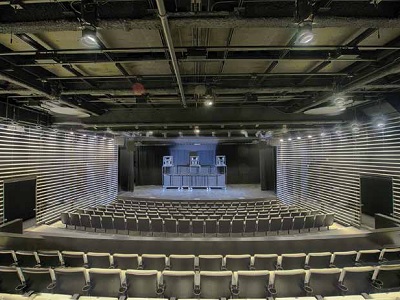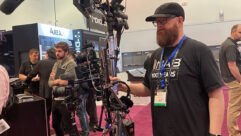

The Phyllis Wattis Theater at the newly renovated and revitalized San Francisco Museum of Modern Art needed to be completely reimagined for multi-purpose use with an emphasis on intelligibility of spoken word and cinema, and clarity and intimacy of music. Architectural firm EHDD led the project and its president, Duncan Ballash, is going to tell us about designing its Phyllis Wattis Theater and outfitting it with the Meyer Constellation active acoustic sound system. We’ll also hear from Pierre Germain, Constellation design manager at Meyer Sound.
SVC: There’s no bigger story right now in the San Francisco area than the complete architectural overhaul that you gave the museum centered on the facility’s Phyllis Wattis Theater. It was designed for versatility with a lot of different things going on in there. So how did the wide range of uses figure into your design for that space?
Duncan Ballash: It was really central. Essentially the client asked us to design a space that they could use for film screening, for lectures and discussions, including their staff meetings, music performance, and then special events; a space that they could even rent out. This type of flexible, small performance space is something that we’re seeing is a real trend in both cultural buildings and educational buildings; spaces that can meet a variety of needs. And so it’s something that we’ve been working on a lot lately. The first thing that I looked at in designing this space was flexibility of the stage. It was really important that there would be easy access from the audience seating area up to the stage so that there could be a strong connection and interaction between the audience and stage. People could come up on the stage during certain uses of the space. Also sizing the stage so that it could accommodate moderate performance, a small green room in the back, and then multiple projection screens, the masking associated with these screens, and then the drapery for different uses. And then we also looked at the acoustic requirements of the different uses, how the room geometry would affect the acoustics as well as what the right wall finishes were and how that would affect the ultimate acoustic design. And then finally the seating layout, making sure we had good sight lines and accessibility throughout the audience.
And this was extensive; not like just re-doing the seating. I read where half of the theater was removed and replaced. How did that happen?
As part of the new edition for SFMOMA, they needed to take out the administrative wing, which divided their remaining site in half in order to get one large, clean site. The existing Wattis Theater spanned underneath this administrative wing so the architects put in a 10-story new addition that needed its structure to go all the way down to new foundations in the ground. So essentially it came right through where the theater was. That was really the starting point of our design.

Along the side aisles that are separated from the seating by a screen, Ballash has the Meyer Sound speakers fairly prominently located above your head as you’re walking into the theater so you get a little bit of a glimpse of the kind of behind-thescenes workings of the design of this space.
Now did you design this right from the beginning for the Meyer Sound Constellation acoustic system or did that become evident as you moved along with the design?
We actually first looked at utilizing natural acoustics where sound reflections occur off architectural finish materials. But as we were analyzing the space for its different uses, as well as some of the architectural impacts of the new addition, one key factor was the large beams that needed to support this 10-story new edition above the theater, it ended up reducing the ceiling height. So we started to see challenges with the geometry in accomplishing the acoustical effects we wanted using natural acoustics and reflections. At that point we started talking about the Meyer Sound Constellation System, which is a system that utilizes virtual acoustics in order to tune a space to its optimum reverberation times and allow us to avoid some of the challenges of the spatial geometry. And it does that essentially by using speakers that allow sound to move across the space, back and forth across the speakers rather than reflecting off architectural surfaces. We could tune the acoustics to really any space, to any need or use that was appropriate for their program. One of the additional benefits that we saw with the Constellation system was, as part of it, there’s also a grid of microphones that extend above the stage and over the audience. We saw this as a great opportunity to allow direct communication from anywhere within the audience chamber to the stage that would allow a one-on-one communication during staff meetings, question-and-answer during lectures, and other things.
And that wasn’t a new concept for you because I think you had specified it for the San Francisco Exploratorium and some other places.
Yeah. It’s actually the third time we’ve utilized this system in a cultural building in San Francisco over the last few years. The first was at the Exploratorium, which is a science center on San Francisco’s waterfront. And there they are looking for, once again, a very versatile, mixed-use assembly space where they could do film screening, lectures, and other projections and it worked fantastic there. Just recently, a project that we worked on for the Berkeley Art Museum and Pacific Film Archive over in Berkeley had a similar-sized 300-seat theater that they wanted to be able to utilize for classroom use, for film screening, lectures, other things. So we ended up using the Meyer Sound Constellation system there also because of that flexibility of use.
You obviously can’t do away with natural acoustics altogether unless everybody is wearing headphones but did the original theater space need to be made as dead or acoustically neutral as possible to set the stage for the Constellation active acoustic system?
Yeah. In the Berkeley Art Museum project we actually incorporated both natural acoustics and the Meyer system, but at the Wattis Theater we’re really focusing on using the Constellation sound system exclusively for our acoustics because of some of these geometric challenges. We did cover all of the walls with acoustic wall panels that were very absorptive so that Meyer technicians have complete control over the tuning of the space for whatever its use was going to be, whether it’s live music or film, to get the acoustics tuned perfectly for that particular use.
How do you hide all of the mechanics of this system, the mics, the speakers, the cabling and everything? All of that is out of view and just blended in with the building?
It is in the audience seating area. In that area I did the ceiling all painted out black, all of the ducts and cabling. So the microphones, the speakers, everything we did black. And then we, through the utilization of light, making sure that there was shadow on the ceiling and lighting on the walls taking your view away from the ceiling. Essentially it all goes away, but I did want to highlight the system as you were entering the theater. And so along the side aisles that are separated from the seating by a screen, we have the Meyer Sound speakers fairly prominently located above your head as you’re walking into the theater so you get a glimpse of the kind of behind-the-scenes workings of the design of this space.
And who actually did the hanging of the speakers and the installation of the equipment and running the cabling and all that?
Our design/build contractor was BBI Engineering who are leaders in AV and sound installation in the United States. They were really fantastic to work with.
This is a unique project and it was a substantial change to the building. What was the most difficult or challenging aspect of designing and building the new Wattis Theater?
For us it was really schedule. This project needed to be done in time for the opening of the new edition to SFMOMA. It’s a fairly complex space; doing the Constellation system and integrating it in with the architecture. And so the biggest challenge was working together as a team, all of the design team, EHDD, our acoustical engineers, Arup, Auerbach, our theater consultant, BBI Construction as well as Meyer Sound and Webcor General Contracting. And the team really came together during design all the way through construction making sure that the right decisions were made quickly, that everybody had the information. So the challenge became a really inspiring exercise in what you can do when you work together as a team.

With the Constellation system was, there’s a grid of microphones that extend above the stage and over the audience. This allows direct communication from anywhere within the audience chamber to the stage that would allow a one-on-one communication during staff meetings, and question-and-answer during lectures.
That is a big team and a lot of people to coordinate with a very firm deadline working at the newly-remodeled and reopened San Francisco Museum of Modern Art. So speaking of teamwork, let’s hear from Pierre Germain on how active acoustic technology works.
Pierre Germain: It’s called active acoustic technology, but it’s also a passive way of changing room acoustics. Active acoustics is a method of changing the reverberation time and the acoustics of a space just to suit it to different needs. So you can have a cinema space that can be changed into a cathedral or chamber music hall or concert hall, all electronically. So traditionally the way that’s been done has been using passive materials like curtains or soft panels that can be moved in and out to change the reflective nature of certain walls and ceilings. Another way of doing that passively is to use coupled chambers, which are additional hallways that can be exposed to the room to increase the volume which also increases the reverberation time. So the way active technology works, it’s a system of microphones and speakers and digital signal processors that work with the room and can change its properties electronically. So you’re essentially replacing walls and ceilings with microphones and speakers, virtually, and that way you can manipulate the shape of the room and the sound of the room.
And that would give you just a whole new dimension of control over everything.
Absolutely. We can control the apparent depth, the apparent height. We can make one wall seem like it’s 100 feet away or 10 feet away. We can really manipulate a lot of the different parameters that you can’t really do in a physical space. For instance, you can adjust the bass ratio – how much base that you want in the room – or the brightness. So the frequency ratio, the sound level – how loud you want it – and also just the overall apparent shape of the room can all be adjusted.
That’s a huge advantage because of the widely-varied nature of the things that are planned to happen in the Phyllis Wattis Theater. For instance, how would you set up a Constellation system differently for a symphonic concert than, say, maybe a lecture or panel discussion?
The only difference is for a panel lecture, instead of using a long reverberation time, we actually use a very short reverberation time. And using the early reflections processor we just use those signals to be broadcast throughout the entire space. We call that a classroom setting. It keeps it very intimate, but at the same time it actually maintains the clarity by not introducing very much reverberation, but rather the early reflections that are essential for speech intelligibility and clarity. Whereas for a symphonic setting, we still have the early reflections to maintain the clarity, but then we have the reverberation which follows it, and that way you get the envelopment and you get the impression that you’re in the concert hall.
Of course, the physical basis of this is lots of microphones and speakers all working together, so what type of microphones would you put in there? Obviously, they’re specialized for that type of use, I guess.
Yes, correct. We have two different microphones in the Wattis. We have our miniature cardioid microphones in the over-the-audience area, and the stage has our compact cardioid microphones, so they’re both cardioid patterns. The ones on stage are a little bit tighter cardioid pattern for a little bit more control.
And the speakers I would think might be fairly directional?
Most of them are 100-degree conical speakers. So the ones up in the ceiling – both on stage and in the audience – are 100-degree conical. The cinema surrounds, which also double as Constellation lateral speakers, are also 100-degree conical. There are smaller speakers, the MM4’s that are embedded in this transondent wall, those are 80-degree conical. And onstage the lateral speakers are horn-loaded and those are 50-degree vertical and 80-degree horizontal.
And a lot of these may involve audience participation where there can be conversation going back and forth between the audience and the stage.
Correct. Yes. They can use the classroom setting for that so they can have participation from the audience, and again it’s a very short reverberation with early reflections where we can maintain the clarity. So wherever you’re sitting there’s a microphone that’s nearby and you can talk to somebody on stage.
When you install the mics and speakers are they pretty much installed the same way from one venue to another or do the natural acoustics of the room determine the placement and separation of the various physical elements?
Yeah, exactly. The base room acoustics sets the distance between microphones and speakers that we want to set and space them at. And then apart from that, depending on the size of the room, it can change the type of speaker that we’re using, because we want to make sure we have enough sound power in the system. And then we try to have as much even spacing as possible to try to cover as many areas. In areas where speakers might end up closer to listeners, we have a higher density of speakers to make sure that you’re not localizing to one particular speaker.
I would think that just using active acoustic technology and knowing this from the beginning and designing the facility for it, you could potentially come up with more than nice aesthetics but actually save tons of time and money.
Yes. Absolutely. That’s the beauty of active architecture. You’re able to transform a small room into much bigger rooms that would normally require a bigger footprint and therefore more impact on the cost of the building and the cost of running the building. So a room of this size, which I believe is only about 200 seats, making it sound like a concert hall is just such a huge advantage. So it gives them flexibility, especially in a museum space, to do all sorts of different events all in a small, compact theater.

In the audience seating area, the ceiling is painted black, along with all the ducts and cabling. Through the utilization of light, shadow on the ceiling and lighting on the walls take the view away from the ceiling.
What was the most difficult or challenging part of installing the Constellation system in this particular venue?
I’d say the most challenging part was there’s these transondent walls that frame the seating area. So essentially that creates a vomitory between the transondent wall and the physical wall. But we do have our cinema speakers around the physical wall and they have to shoot through the transondent wall. So there were a lot of design meetings to look at the metal slats that we were doing in this wall to make sure that it wasn’t compromising the frequency pattern of the speakers. So it was a great collaboration between EHDD, BBI the installer, and Arup, the acoustician. They did some testing at their office. BBI did some good ray tracing analysis to give some guidance to the architect in terms of the angle and the depth and the size of these slats in the metal wall. Once we tested everything onsite, everything worked out perfectly and our speakers sounded great. In addition to that, we also added some speakers inside the slats. It worked out that the spacing fit our speakers perfectly.
How do you control the system in the Wattis Theater?
It’s controlled by a Crestron panel, which controls other systems in the room, which is pretty typical for a Constellation system. The main presets are all in the Creston panel and if they want to have the ability to go into each preset and manipulate things a little bit, they have a web page that we program that they can access from a computer or an iPad. And then they have a details page where they can go and adjust things here and there. So if they have a symphony setting and they want to make it a little bit quieter, they have the ability to do that.
So when you got all of this in and got it set up, the really fun part of it has to be the demo when you get to show the system off and show what it can do. People actually go beyond the verbal descriptions and hear what it can do for the first time. So what kind of reactions did you get when you first demoed this for everybody?
That’s always a lot of fun. We usually leave that for the last day of the tuning. What we typically do is—and we did this here—we invited musicians to come and play for us. In this case we had a quartet from the San Francisco Symphony. At first they started with our chamber setting. We got them to play some up tempo pieces and some staccato pieces and some pizzicato. And just turning the system on and off, the reaction is usually gasps from the audience, which is the best reaction. And musicians always tell me when the system is turned off, they feel very exposed. They feel like they’re not integrated with the room at all. It’s always great to hear the reactions of both the audience and the musicians. And then we went on to slower legato pieces and we changed it to symphonic setting and even the cathedral setting. The difference between the cathedral setting and the system off is really dramatic because it’s about a five second reverberation time in the cathedral setting and then we turn it off and it goes back to the natural room acoustics, which is half a second. So it’s really dramatic. A lot of people had their phones out videotaping the on/off because it really is quite staggering.
Yeah, I can imagine for musicians in particular. They can go from playing in a symphonic hall to playing in a closet with the push of a button.
Absolutely, yeah.
This type of theater would be the first thing that comes to mind but I would imagine that this active acoustic system can do a lot of other things in a variety of other venues.
Constellation is obviously an ideal solution for a range of applications. It applies not only in the arts community, but also corporate and education and restaurants. So the system has been expanded to meet the needs of many different markets now.









